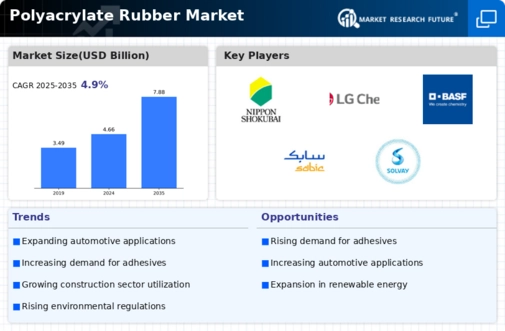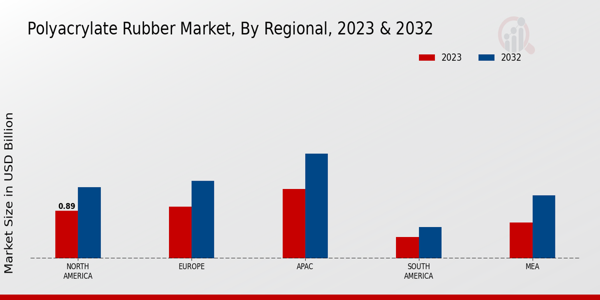Market Growth Projections
The Global Polyacrylate Rubber Market Industry is projected to experience substantial growth over the next decade. With a market value of 4.66 USD Billion in 2024, it is anticipated to reach 7.88 USD Billion by 2035, reflecting a robust expansion trajectory. The compound annual growth rate (CAGR) of 4.89% from 2025 to 2035 indicates a steady increase in demand across various sectors, including automotive, construction, and healthcare. This growth is likely driven by the rising adoption of polyacrylate rubber in diverse applications, showcasing its versatility and performance advantages in the global market.
Growth in Construction Activities
The Global Polyacrylate Rubber Market Industry is significantly influenced by the growth in construction activities worldwide. As urbanization accelerates, there is an increasing need for high-performance materials in construction applications, including sealants and adhesives. Polyacrylate rubber's properties, such as weather resistance and flexibility, make it suitable for various construction projects. The anticipated growth in the construction sector is expected to propel the market forward, contributing to the projected increase in market value to 7.88 USD Billion by 2035. This growth indicates a robust demand for polyacrylate rubber in the construction industry.
Expanding Applications in Healthcare
The Global Polyacrylate Rubber Market Industry is witnessing an expansion of applications in the healthcare sector. Polyacrylate rubber's biocompatibility and flexibility make it suitable for medical devices, seals, and adhesives used in healthcare applications. As the healthcare industry continues to evolve, there is a growing need for reliable and high-performance materials that can withstand sterilization processes and provide durability. This trend is expected to contribute to the overall growth of the market, as healthcare providers increasingly adopt polyacrylate rubber in their products, thereby enhancing the Global Polyacrylate Rubber Market Industry's value.
Rising Demand from Automotive Sector
The Global Polyacrylate Rubber Market Industry experiences a notable surge in demand driven by the automotive sector. As manufacturers increasingly prioritize lightweight and durable materials for vehicle production, polyacrylate rubber emerges as a preferred choice due to its excellent elasticity and resistance to aging. In 2024, the market is projected to reach 4.66 USD Billion, reflecting the automotive industry's shift towards advanced materials. This trend is likely to continue, with the Global Polyacrylate Rubber Market Industry expected to expand as electric vehicle production rises, necessitating materials that enhance performance and efficiency.
Technological Advancements in Manufacturing
Technological advancements in manufacturing processes are reshaping the Global Polyacrylate Rubber Market Industry. Innovations in polymerization techniques and compounding methods enhance the performance characteristics of polyacrylate rubber, making it more appealing to various industries. These advancements not only improve product quality but also optimize production efficiency, thereby reducing costs. As manufacturers adopt these technologies, the market is poised for growth, with a projected CAGR of 4.89% from 2025 to 2035. This trend suggests that the Global Polyacrylate Rubber Market Industry will benefit from increased competitiveness and product diversity.
Environmental Regulations and Sustainability
The Global Polyacrylate Rubber Market Industry is increasingly shaped by stringent environmental regulations and a growing emphasis on sustainability. Manufacturers are compelled to develop eco-friendly products that comply with regulations aimed at reducing environmental impact. Polyacrylate rubber, known for its low toxicity and recyclability, aligns well with these sustainability goals. As industries seek to minimize their carbon footprint, the demand for sustainable materials is likely to rise, further driving the growth of the Global Polyacrylate Rubber Market Industry. This shift towards greener alternatives may also influence product development strategies across various sectors.
















